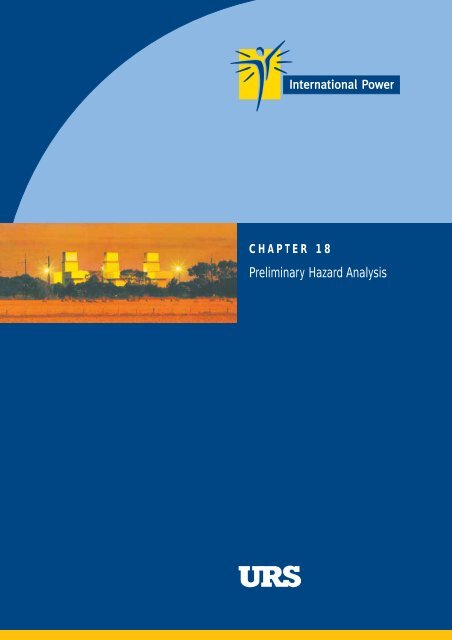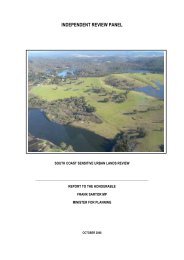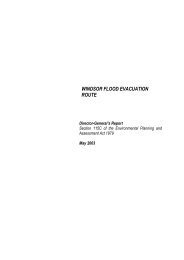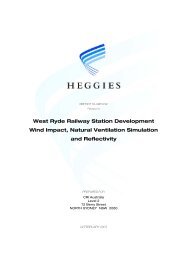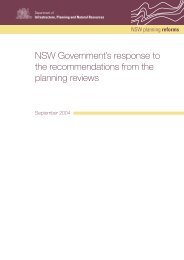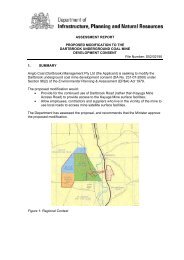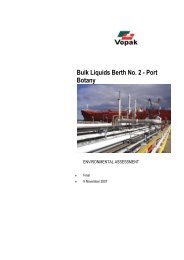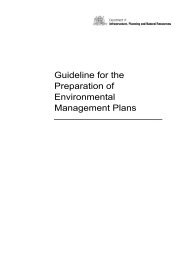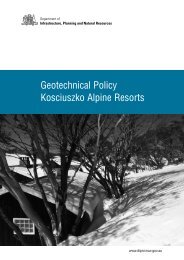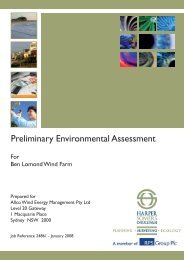Preliminary Hazard Analysis - Department of Planning
Preliminary Hazard Analysis - Department of Planning
Preliminary Hazard Analysis - Department of Planning
You also want an ePaper? Increase the reach of your titles
YUMPU automatically turns print PDFs into web optimized ePapers that Google loves.
CHAPTER 18<br />
<strong>Preliminary</strong> <strong>Hazard</strong> <strong>Analysis</strong>
18 Prelimin ary <strong>Hazard</strong> An alysis<br />
E N V I R O N M E N T A L A S S E S S M E N T<br />
<strong>Preliminary</strong> <strong>Hazard</strong> <strong>Analysis</strong> Chapter 18<br />
<strong>Preliminary</strong> <strong>Hazard</strong> <strong>Analysis</strong> – Summary <strong>of</strong> Outcomes<br />
The preliminary hazard analysis (PHA) assessment has been carried out in accordance with the<br />
<strong>Department</strong> <strong>of</strong> <strong>Planning</strong>’s HIPAP No 4 (Risk Criteria for Land Use <strong>Planning</strong>) and HIPAP No 6<br />
(Guidelines for <strong>Hazard</strong> <strong>Analysis</strong>). The main hazard associated with the proposed project is associated<br />
with the handling <strong>of</strong> the distillate, a combustible fuel used to power the gas turbines.<br />
Other, less significant hazards may arise in fixed plant, storage and associated pipelines. The risk<br />
analysis showed that the risk <strong>of</strong> fatality does not extend anywhere outside the boundaries and it is<br />
considered that the proposed development does not have a significant impact on societal risk. The<br />
risk associated with the transport <strong>of</strong> dangerous goods and potentially hazardous materials is very low.<br />
The most stringent risk criteria, as required by the <strong>Department</strong> <strong>of</strong> <strong>Planning</strong>, are adhered to.<br />
The risk assessment carried out in this study assumed that the safety assessment process would<br />
continue throughout the design, construction and commissioning <strong>of</strong> a potentially hazardous facility to<br />
refine and update the outcome <strong>of</strong> the development approval / environmental risk process.<br />
Herons Creek Peaking Power Plant<br />
18-1
E N V I R O N M E N T A L A S S E S S M E N T<br />
Chapter 18<br />
<strong>Preliminary</strong> <strong>Hazard</strong> <strong>Analysis</strong><br />
18.1 Introduction<br />
The <strong>Department</strong> <strong>of</strong> <strong>Planning</strong>’s Multi Level Risk Assessment Guidelines, aim to provide a guide to the<br />
level <strong>of</strong> assessment necessary for an operation being studied. In accordance with these guidelines<br />
and as part <strong>of</strong> the Environmental Assessment, a quantitative <strong>Preliminary</strong> <strong>Hazard</strong> Assessment (PHA)<br />
was prepared for the proposed Herons Creek Peaking Power Plant Project. The following sections<br />
summarize the results <strong>of</strong> the PHA undertaken by Planager Risk Management Consulting for the<br />
proposed Peaking Power Plant. The full report is presented in Appendix H.<br />
The assessment has been carried out in accordance with the <strong>Department</strong> <strong>of</strong> <strong>Planning</strong>’s <strong>Hazard</strong>ous<br />
Industry <strong>Planning</strong> Advisory Paper (HIPAP) No 4 (Risk Criteria for Land Use <strong>Planning</strong>) and No 6<br />
(Guidelines for <strong>Hazard</strong> <strong>Analysis</strong>). These documents describe the methodology and the criteria to be<br />
used in PHAs, as required by the <strong>Department</strong> <strong>of</strong> <strong>Planning</strong> for major “potentially hazardous”<br />
development.<br />
In accordance with <strong>Department</strong> <strong>of</strong> <strong>Planning</strong>’s HIPAP No. 3 (Environmental Risk Impact Assessment<br />
Guidelines), the safety assessment process would continue throughout the design, construction and<br />
commissioning <strong>of</strong> a potentially hazardous facility to refine and update the outcome <strong>of</strong> the development<br />
approval / environmental risk process.<br />
18.2 Methodology<br />
The process for PHA follows a number <strong>of</strong> steps which provide assurances that risks imposed by a<br />
development upon surrounding land uses would be within acceptable limits and that this would<br />
continue to be the case throughout the life <strong>of</strong> the development.<br />
The objective <strong>of</strong> the PHA is to present the hazards and risks associated with the proposed distillate<br />
fuelled gas turbine peaking power plant. Through the evaluation <strong>of</strong> likelihood and consequence <strong>of</strong> the<br />
major hazards, the risks to the community associated with the proposed Peaking Power Plant may be<br />
estimated and compared to <strong>Department</strong> <strong>of</strong> <strong>Planning</strong> risk criteria.<br />
The risk assessment has quantitatively determined the risk <strong>of</strong> fatality and injury to the public<br />
associated with the handling and processing <strong>of</strong> potentially hazardous material at the proposed<br />
development.<br />
The report assesses the risks from the following facilities and activities:<br />
• The distillate fired peaking power plant; and<br />
• Transport <strong>of</strong> potentially hazardous material (such as fuels) to the facility<br />
The PHA notes that there are five stages in risk assessment, each <strong>of</strong> which is described below.<br />
Stage 1 – <strong>Hazard</strong> Identification<br />
The hazard identification includes a review <strong>of</strong> potential hazards associated with all dangerous and<br />
hazardous goods to be processed, used and handled at the peaking power plant and associated<br />
pipelines and facilities. The hazard identification includes a comprehensive identification <strong>of</strong> possible<br />
causes <strong>of</strong> potential incidents and their consequences to public safety and the environment, as well as<br />
an outline <strong>of</strong> the proposed operational and organisational safety controls required to mitigate the<br />
likelihood <strong>of</strong> the hazardous events from occurring.<br />
Herons Creek Peaking Power Plant<br />
18-2
E N V I R O N M E N T A L A S S E S S M E N T<br />
<strong>Preliminary</strong> <strong>Hazard</strong> <strong>Analysis</strong> Chapter 18<br />
The tasks involved in the hazard identification <strong>of</strong> the proposed facility included a review <strong>of</strong> all relevant<br />
data and information to highlight specific areas <strong>of</strong> potential concern and points <strong>of</strong> discussion, including<br />
drafting up <strong>of</strong> preliminary hazard identification word diagram. The hazard identification word diagram<br />
is then reviewed and complete in a workshop which included people with operational / engineering /<br />
risk assessment expertise. The review takes into account both random and systematic errors, and<br />
gives emphasis not only to technical requirements, but also to the management <strong>of</strong> the safety activities<br />
and the competence <strong>of</strong> people involved in them.<br />
Stage 2 – Consequence and Effect <strong>Analysis</strong><br />
The consequences <strong>of</strong> identified hazards are assessed using current techniques for risk assessment.<br />
Well established and recognised correlations between exposure and effect on people are used to<br />
calculate impacts.<br />
Stage 3 – Frequency <strong>Analysis</strong><br />
For incidents with significant effects, whether on people, property or the biophysical environment, the<br />
incident frequency are estimated, based on historical data. A probabilistic approach to the failure <strong>of</strong><br />
vessels and pipes is used to develop frequency data on potentially hazardous incidents.<br />
Stage 4 – Quantitative Risk <strong>Analysis</strong><br />
The combination <strong>of</strong> the probability <strong>of</strong> an outcome, such as injury or death, combined with the<br />
frequency <strong>of</strong> an event gives the risk from the event. The risk for each incident is calculated according<br />
to:<br />
Risk = Consequence x Frequency<br />
Total risk is obtained by adding together the results from the risk calculations for each incident, i.e. the<br />
total risk is the sum <strong>of</strong> the risk calculated for each scenario.<br />
The results <strong>of</strong> the risk analysis are presented in three forms:<br />
• Individual Fatality Risk, i.e. the likelihood (or frequency) <strong>of</strong> fatality to notional individuals at<br />
locations around the site, as a result <strong>of</strong> any <strong>of</strong> the postulated fire and explosion events. The units<br />
for individual risk are probability (<strong>of</strong> fatality) per million per year. Typically, the result <strong>of</strong> individual<br />
risk calculations is shown in the form <strong>of</strong> risk contours overlaid on a map <strong>of</strong> the development area.<br />
For pipelines (as for other transport activities), the individual risk contours are best represented<br />
as risk transects, showing the risk as a function <strong>of</strong> the distance from the pipeline.<br />
• Injury and irritation risk, i.e. the likelihood <strong>of</strong> injury to individuals at locations around the site as a<br />
result <strong>of</strong> the same scenarios used to calculate individual fatality risk.<br />
• Societal risk takes into account the number <strong>of</strong> people exposed to risk. Whereas individual risk is<br />
concerned with the risk <strong>of</strong> fatality to a (notional) person at a particular location (person 'most at<br />
risk', i.e. outdoors), societal risk considers the likelihood <strong>of</strong> actual fatalities among any <strong>of</strong> the<br />
people exposed to the hazard. Societal risk are presented as so called f-N curves, showing the<br />
frequency <strong>of</strong> events (f) resulting in N or more fatalities. To determine societal risk, it is necessary<br />
to quantify the population within each zone <strong>of</strong> risk surrounding a facility. By combining the risk<br />
results with the population data, a societal risk curve can be produced.<br />
The risk results are then assessed against the guidelines adopted by the <strong>Department</strong> <strong>of</strong> <strong>Planning</strong>.<br />
Herons Creek Peaking Power Plant<br />
18-3
E N V I R O N M E N T A L A S S E S S M E N T<br />
Chapter 18<br />
<strong>Preliminary</strong> <strong>Hazard</strong> <strong>Analysis</strong><br />
Stage 5 – Risk Reduction<br />
Where possible, risk reduction measures are identified throughout the course <strong>of</strong> the study in the form<br />
<strong>of</strong> recommendations.<br />
18.3 Risk Criteria<br />
Once the risk from a development is determined it must then be compared with accepted criteria in<br />
order to assess whether or not the risk level is tolerable. If not, specific measures must be taken to<br />
reduce the risk to a tolerable level. Where this is not possible, it must then be concluded that the<br />
proposed development is not compatible with the existing surrounding land uses.<br />
18.3.1 Individual Risk Criteria<br />
The individual fatality risk is the probability <strong>of</strong> fatality to a person or a facility at a particular point. It is<br />
usually expressed as chances per million per year (pmpy). It is assumed that the person will be at the<br />
point <strong>of</strong> interest 24 hours per day for the whole year. By convention in NSW, no mitigation is allowed,<br />
i.e. any possible evasive action that could be taken by a person exposed to a hazardous event, e.g. by<br />
walking out <strong>of</strong> a toxic cloud or a heat radiation. The assessment <strong>of</strong> fatality, incident propagation and<br />
injury risk should include all components contributing to the total risk, i.e. fire and explosion.<br />
The <strong>Department</strong> <strong>of</strong> <strong>Planning</strong> uses a set <strong>of</strong> guidelines on acceptable levels or individual risk which are<br />
in line with the criteria used elsewhere in the world. These guidelines are published in the <strong>Hazard</strong>ous<br />
Industry <strong>Planning</strong> Advisory Paper No. 4: Risk Criteria for Land Use Safety <strong>Planning</strong>.<br />
18.3.2 Societal Risk Criteria<br />
Societal risk is concerned with the potential for an incident to coincide in time and space with a human<br />
population. Societal risk takes into account the potential for an incident to cause multiple fatalities.<br />
Therefore, two components are relevant, namely:<br />
• The number <strong>of</strong> people exposed in an incident, and<br />
• The frequency <strong>of</strong> exposing a particular number <strong>of</strong> people.<br />
In the absence <strong>of</strong> published criteria in HIPAP 4, the criteria in the 1996 regional study <strong>of</strong> Port Botany<br />
by the <strong>Department</strong> <strong>of</strong> <strong>Planning</strong> were used in the Herons Creek Peaking Power Plant PHA for<br />
indicative purposes.<br />
The societal risk criteria specify levels <strong>of</strong> societal risk which must not be exceeded by a particular<br />
activity. The same criteria are currently used for existing and new developments. Two societal risk<br />
criteria are used, defining acceptable and unacceptable levels <strong>of</strong> risk due to a particular activity.<br />
Three zones are thus defined:<br />
• Above the unacceptable/intolerable limit the societal risk is not acceptable whatever the<br />
perceived benefits <strong>of</strong> the development.<br />
• The area between the unacceptable and the acceptable limits is known as the ALARP (as low as<br />
reasonably possible) region. Risk reduction may be required for potential incidents in this area.<br />
• Below the acceptable limit, the societal risk level is negligible regardless <strong>of</strong> the perceived value <strong>of</strong><br />
the activity.<br />
Herons Creek Peaking Power Plant<br />
18-4
E N V I R O N M E N T A L A S S E S S M E N T<br />
<strong>Preliminary</strong> <strong>Hazard</strong> <strong>Analysis</strong> Chapter 18<br />
18.4 Potential for <strong>Hazard</strong> Incidents and Mitigation Measures<br />
18.4.1 Summary <strong>of</strong> <strong>Hazard</strong> Identification Process<br />
<strong>Hazard</strong> Identification<br />
The main hazard associated with the proposed development is related to the handling <strong>of</strong> combustible<br />
liquids (distillate). A list <strong>of</strong> the typical chemicals to be stored on site is provided below in Table 18-1.<br />
<strong>Hazard</strong>s may arise in fixed plant, storage and pipelines. The predominant mode in which a hazardous<br />
incident may be generated is associated with a leak. This would generally only have the potential to<br />
cause injury or damage if there was ignition, which resulted in a fire. The factors involved are:<br />
• Failure must occur causing a release. There are several possible causes <strong>of</strong> failure, with the main<br />
ones being corrosion and damage to the equipment by external agencies;<br />
• The released material must come into contact with a source <strong>of</strong> ignition. In some cases this may<br />
be heat or sparks generated by mechanical damage while in others, the possible ignition source<br />
could include non-flame pro<strong>of</strong> equipment, vehicles, or flames some distance from the release. In<br />
the case <strong>of</strong> distillate, the probability <strong>of</strong> ignition is very low seeing the relatively high flash point <strong>of</strong><br />
the material (about 65 o C), indicating that the source <strong>of</strong> ignition must be very energetic and that<br />
the material would need to have been heated prior to the incident for ignition to occur;<br />
• In case <strong>of</strong> ignition, the result <strong>of</strong> ignition <strong>of</strong> distillate would be a pool fire. The size <strong>of</strong> the pool fire<br />
depends on the release conditions, including the mass <strong>of</strong> material involved and how rapidly it is<br />
ignited.<br />
• Finally, for there to be a risk, people must be present within the harmful range (consequence<br />
distance) <strong>of</strong> the fire. How close the people are will determine whether any injuries or fatalities<br />
result.<br />
Table 18-1<br />
Typical Chemicals Stored On Site<br />
Plant Area / Use Chemical/Product Anticipated Storage Qty<br />
Fuel for gas turbines Low Sulphur Distillate 2 x 1,000 kL in fixed tanks<br />
Turbines Turbine oils (combustible oil) 3 x 7,000 L in containment integral to<br />
each turbine<br />
Transformers, pumps, air<br />
compressor, lubrication, fire pump<br />
Water treatment plant (RO Plant)<br />
Chemicals for maintenance / repair<br />
work and clean-up<br />
Insulating oil (non PCB)<br />
Caustic soda (50%)<br />
Hydrochloric acid (36%)<br />
Antiscalant<br />
Citric acid<br />
Sodium hypochlorite<br />
Carbon dioxide<br />
1,000 L in one bulk container C or<br />
drums<br />
1,000L in one bulk container<br />
1,000L in one bulk container<br />
1,000L in one bulk container<br />
1,000 in one bulk container<br />
Minor quantities in lockable chemicals<br />
cabinet<br />
In cylinders, auto fire protection inside<br />
gas turbine enclosures<br />
Herons Creek Peaking Power Plant<br />
18-5
E N V I R O N M E N T A L A S S E S S M E N T<br />
Chapter 18<br />
<strong>Preliminary</strong> <strong>Hazard</strong> <strong>Analysis</strong><br />
A total <strong>of</strong> 17 hazards were identified for the peaking power plant. These hazards are listed in Table<br />
18-2 below. For each <strong>of</strong> the hazards identified, potential causes, possible consequences and relevant<br />
prevention / protection measures are detailed within Appendix H.<br />
Table 18-2<br />
Summary <strong>of</strong> Identified <strong>Hazard</strong>s<br />
Number<br />
<strong>Hazard</strong>ous Event Potential<br />
Offsite Impact<br />
Potential<br />
1 Loss <strong>of</strong> containment <strong>of</strong> distillate during unloading and storage Y<br />
2 Loss <strong>of</strong> containment <strong>of</strong> distillate during fuel forwarding to gas turbine Y<br />
3 Loss <strong>of</strong> distillate inside gas turbine enclosure Y<br />
4 Unburned distillate inside gas turbine enclosure Y<br />
5 Loss <strong>of</strong> lube oil inside gas turbine enclosure Y<br />
6 Loss <strong>of</strong> containment <strong>of</strong> corrosive liquids N<br />
7 Violent reaction between incompatible materials N<br />
8 Loss <strong>of</strong> containment <strong>of</strong> water treatment plant effluent N<br />
9 Fire at step-up transformers Y<br />
10 Flooding results in process upsets and damage to plant and equipment Y<br />
11 Land subsidence, earthquake or mining activity results in plant damage Y<br />
12<br />
13<br />
Aircraft crash results in process upsets, potential damage to process / piping /<br />
storage facilities resulting in hazardous releases<br />
Damage to plant through terrorism / vandalism / unlawful entry to site /<br />
sabotage<br />
14 Bush / grass fire Y<br />
15 Storm damage Y<br />
16 Incident during maintenance and repair work Y<br />
17<br />
Transport <strong>of</strong> potentially hazardous material to and from the site (diesel, oils,<br />
corrosives)<br />
Y<br />
Y<br />
Y<br />
18.5 Consequence and Frequency <strong>Analysis</strong><br />
For distillate (a combustible liquid), credible incidents arise from ignition <strong>of</strong> leaks or spills, giving rise to<br />
pool fires, where a liquid pool burns at its surface. Pool fires can occur within tanks, in the bunds<br />
around tanks or elsewhere that a pool <strong>of</strong> liquid collects.<br />
PHAs focus on the risk to surrounding land use from a potentially hazardous development. Analysing<br />
the incident scenarios summarised in Table 18-2 above shows that the bund fire scenario caused by a<br />
loss <strong>of</strong> containment <strong>of</strong> distillate during unloading and during storage has the potential to reach outside<br />
the site boundaries.<br />
The likelihood <strong>of</strong> ignition depends on the properties <strong>of</strong> the material, and the size and location <strong>of</strong> the<br />
leak. In the case <strong>of</strong> distillate, the ignition source must be very strong (high in energy) and the material<br />
would most likely need to be heated to above its flash point before ignition could occur (distillate<br />
flashpoint is about 65 o C). A detailed study <strong>of</strong> storage tank incidents in industrial facilities over a 40<br />
year period showed that lightning was the most frequent cause <strong>of</strong> accident and maintenance error was<br />
the second most frequent cause.<br />
Herons Creek Peaking Power Plant<br />
18-6
E N V I R O N M E N T A L A S S E S S M E N T<br />
<strong>Preliminary</strong> <strong>Hazard</strong> <strong>Analysis</strong> Chapter 18<br />
Leak Rates and Duration<br />
The duration <strong>of</strong> a leak will depend on the hardware systems available to isolate the source <strong>of</strong> the leak,<br />
the nature <strong>of</strong> the leak itself and the training, procedures and management <strong>of</strong> the facility. While in<br />
some cases it may be argued that a leak will be isolated within one minute, the same leak under<br />
different circumstances may take 10 minutes or even hour(s) to isolate. The approach used in this<br />
hazard analysis has been to assume that in 50% <strong>of</strong> leak cases, the leak is not discovered until the<br />
bund area is 10% covered and that in the other 50% <strong>of</strong> the leak cases the leak is not discovered until<br />
the entire bund surface is covered. This is a highly conservative approach as revealed during the<br />
analysis process where the tank overfill scenario accounts for about 80% <strong>of</strong> the leak cases and that<br />
operators are present during the tanker unloading.<br />
Radiation Effects – The Point Source Method<br />
Radiation effects have been evaluated using the point source method which assumes that a fire is a<br />
point source <strong>of</strong> heat located at the centre <strong>of</strong> the flame and radiating a proportion <strong>of</strong> the heat <strong>of</strong><br />
combustion. The radiation intensity at any distance is then determined according to the inverse<br />
square law, making allowance for the attenuating effect <strong>of</strong> atmospheric water vapour over significant<br />
distances (i.e. 100m or more).<br />
18.5.1 Impact Assessment<br />
The above techniques allow the level <strong>of</strong> radiation or overpressure resulting from fires and explosions<br />
to be determined at any distance from the source. The effect or impact <strong>of</strong> heat radiation on people is<br />
shown in Table 18-3 below.<br />
Table 18-3<br />
Effects <strong>of</strong> Heat Radiation<br />
Radiant Heat Level<br />
(kW/m 2)<br />
Physical Effect<br />
(effect depends on exposure duration)<br />
1.2 Received from the sun at noon in summer<br />
2.1 Minimum to cause pain after 1 minute<br />
4.7 Will cause pain in 15-20 seconds and injury after 30 seconds’ exposure<br />
12.6 Significant chance <strong>of</strong> fatality for extended exposure<br />
High chance <strong>of</strong> injury<br />
23 Likely fatality for extended exposure and chance <strong>of</strong> fatality for<br />
instantaneous (short) exposure<br />
35 Significant chance <strong>of</strong> fatality for people exposed instantaneously<br />
Herons Creek Peaking Power Plant<br />
18-7
E N V I R O N M E N T A L A S S E S S M E N T<br />
Chapter 18<br />
<strong>Preliminary</strong> <strong>Hazard</strong> <strong>Analysis</strong><br />
18.5.2 Consequence Calculations – Distillate Fire<br />
The consequence <strong>of</strong> a bund fire <strong>of</strong> distillate, as calculated using the Point Source method, are<br />
presented in Figure 18-1 below. A detailed calculation sheet is included in Appendix H. Two<br />
scenarios were investigated, namely a ‘small’ and a ‘large’ fire, covering 10% and 100% <strong>of</strong> the surface<br />
<strong>of</strong> the bund respectively 1 . Serious (potentially fatal) consequences from a ‘small’ bund fire do not<br />
extend beyond the site boundaries.<br />
Figure 18-1<br />
Heat Radiation from Distillate Bund Fire<br />
Heat Radiation<br />
Heat Radiation (kW/m2)<br />
40.0<br />
35.0<br />
30.0<br />
25.0<br />
20.0<br />
15.0<br />
10.0<br />
5.0<br />
Small bund fire<br />
Large bund fire<br />
0.0<br />
0 20 40 60 80 100<br />
Distance from Edge <strong>of</strong> Bund [m]<br />
18.5.3 Probability <strong>of</strong> Operation <strong>of</strong> Plant<br />
The peaking power plant is expected to operate for a maximum <strong>of</strong> 10% <strong>of</strong> the time. Conservatively,<br />
this risk assessment has assumed that the peaking power plant will operate 100% <strong>of</strong> the time and that<br />
all parts <strong>of</strong> the plant will be pressurised, capable <strong>of</strong> releasing distillate if damage occurs, 100% <strong>of</strong> the<br />
time.<br />
1 The bund has not been designed at the time <strong>of</strong> this PHA. This PHA assumed that the bund would be 35 m x 30 m (1050 m 2 ).<br />
Herons Creek Peaking Power Plant<br />
18-8
E N V I R O N M E N T A L A S S E S S M E N T<br />
<strong>Preliminary</strong> <strong>Hazard</strong> <strong>Analysis</strong> Chapter 18<br />
18.5.4 Frequency and Probability Data<br />
The data used for the fault tree analysis as presented within Appendix H <strong>of</strong> this Environmental<br />
Assessment, is listed in Table 18-4 below together with the basis for the calculation and, where<br />
possible, the reference used.<br />
Table 18-4<br />
Frequency and Probability <strong>of</strong> <strong>Hazard</strong> Events<br />
Ref.<br />
Item<br />
Frequency/Prob<br />
ability<br />
Basis <strong>of</strong> Calculation / Reference<br />
2B External Fire Plan Fails 0.05 [t/d] Conservative estimate. Risk engineering best<br />
judgment<br />
4B Ignition 0.001 [t/d] Estimated from Cox, Lees & Ang - Chapter 15,<br />
considered conservative.<br />
4C<br />
5A<br />
Local fire fighting<br />
inadequate/not available<br />
Pump seal failure into<br />
bund<br />
0.3 [t/d] Conservative estimate. Risk engineering best<br />
judgment (site workforce present approx 10%<br />
<strong>of</strong> time, but most incidents will occur during<br />
filling)<br />
0.005 [t/yr] Single mechanical seal, ISORIS data<br />
5B Major leak from tank 1.0E-04 [t/yr] Atmospheric storage tank leak (historical data)<br />
5C External events 1.0E-04 [t/yr] Conservative estimate. Risk engineering best<br />
judgment<br />
5D<br />
Faulty fabrication or<br />
corrosion at tank<br />
1.0E-04 [t/yr] Data from the Rijnmond study (Cremer &<br />
Warner), subsequently used by Bureau Veritas<br />
for the Kwinana study<br />
5E Flange leak inside bund 2.5E-05 [t/yr] Estimated from Cox, Lees & Ang - Chapter 15,<br />
assuming 5 flanges per tank<br />
5G Foam u/s or empty 0.2 [t/d] Conservative estimate. Risk engineering<br />
judgment<br />
5H<br />
Too windy / no access<br />
makes foam useless<br />
0.2 [t/d] Conservative estimate. Risk engineering<br />
judgment<br />
6A Pipe failure inside bund 3.0E-04 [t/yr] Estimated from Cox, Lees & Ang - Chapter 15.<br />
6B Vandalism 0.002 [t/yr] Conservative estimate. Risk engineering<br />
judgment<br />
6C<br />
Operator fails to act on<br />
overflowing tank<br />
0.01 [t/d] Orica Engineering HAZAN Course Notes,<br />
Section 11.<br />
7A Level transmitter fails 0.1 [t/y] Orica Engineering HAZAN Course Notes,<br />
Section 5.<br />
8A<br />
8B<br />
Operator fails to<br />
intervene at high level<br />
No <strong>of</strong> fills per tank per<br />
year<br />
0.05 [t/d] Orica Engineering HAZAN Course Notes,<br />
Section 11.<br />
50 [t/yr] Site data<br />
Herons Creek Peaking Power Plant<br />
18-9
E N V I R O N M E N T A L A S S E S S M E N T<br />
Chapter 18<br />
<strong>Preliminary</strong> <strong>Hazard</strong> <strong>Analysis</strong><br />
18.6 Risk Assessment<br />
18.6.1 Fatality Risk Calculation<br />
The likelihood <strong>of</strong> a bund fire, taking into account the properties <strong>of</strong> the distillate and its use within the<br />
site, is very low. For the two tank bund proposed for the site, the likelihood <strong>of</strong> a large fire (covering the<br />
entire surface <strong>of</strong> the bund) is about 0.5 pmpy. It then follows that the <strong>of</strong>fsite individual risk from the site<br />
is less than 0.5 pmpy <strong>of</strong>f the site.<br />
Hence, the risk <strong>of</strong> a distillate fire is minimal, provided the storage is designed in accordance with code<br />
requirements (in particular AS1940) and the layout design and on site fire protection and management<br />
systems as presented in Chapter 13 Bushfire Risk.<br />
18.6.2 Environmental Risk<br />
Some materials to be stored and handled on site are potentially highly damaging to the environment,<br />
such as the water treatment chemicals and distillate. The possible sources <strong>of</strong> risks are liquid loss <strong>of</strong><br />
containment or firewater run<strong>of</strong>f while a fire is being extinguished.<br />
The liquid inventories on-site are listed in Table 18-1 above. Losses <strong>of</strong> containment <strong>of</strong> materials can<br />
be caused in the ways discussed in the <strong>Hazard</strong> Identification Word Diagram provided within<br />
Appendix H. However if a spillage occurs into a sealed bund which has sufficient volume to contain<br />
the spill, there is no contamination <strong>of</strong> ground or water. Spillages to ground while filling tanks or<br />
unloading from tankers are thus the most probable source <strong>of</strong> loss <strong>of</strong> containment. Pollution is<br />
prevented by ensuring that liquids handling areas are paved, contained or drained to the interceptor<br />
pit.<br />
18.6.3 Transport Risk<br />
It is expected that about 30 deliveries per year will be sufficient for the operation <strong>of</strong> the site, mainly<br />
consisting <strong>of</strong> the distillate deliveries and the occasional delivery <strong>of</strong> corrosive liquids to the Water<br />
Treatment Plant, oil top up for rotating machinery and possibly the transport <strong>of</strong> material used for<br />
maintenance or cleaning.<br />
Road transportation would use the Pacific Highway to access the site. The entrance road to the site is<br />
to be <strong>of</strong> adequate construction for the use in accordance with Port Macquarie - Hastings Council and<br />
RTA requirements, and would be maintained and repaired as required.<br />
General transport risks <strong>of</strong> these materials are handled by transport companies’ internal safety<br />
requirements. Clean up and incident management will be as per the transport company's procedures.<br />
The quantities and transport movement <strong>of</strong> potentially hazardous materials for this site are well below<br />
those listed in the Transportation Screening Threshold table (Table 2 in the guidelines on applying<br />
SEPP 33) as defined by the <strong>Department</strong> <strong>of</strong> <strong>Planning</strong>.<br />
The review <strong>of</strong> road transport risks concludes that the risk associated with the transport <strong>of</strong> dangerous<br />
goods and potentially hazardous material to the site is very low.<br />
Herons Creek Peaking Power Plant<br />
18-10
E N V I R O N M E N T A L A S S E S S M E N T<br />
<strong>Preliminary</strong> <strong>Hazard</strong> <strong>Analysis</strong> Chapter 18<br />
18.7 Risk Results - Adherence to Risk Criteria<br />
The quantitative analysis showed that:<br />
Individual Risk <strong>of</strong> Fatality: The risk <strong>of</strong> fatality at the nearest residential area is well below the<br />
criterion for new installations <strong>of</strong> one chance in a million per year (1 x 10 -6 /yr). The 1 x 10 -6 /yr individual<br />
fatality risk for the proposed peaking power plant is contained well within the site boundaries.<br />
It follows that the risk <strong>of</strong> fatality at the nearest open space and the nearest industrial area are also well<br />
below the criterion <strong>of</strong> ten and fifty chances per million years respectively (10 x 10 -6 /yr and 50 x 10 -6 /yr)<br />
and contained within side boundaries.<br />
Injury Risk: The risk <strong>of</strong> injury at the nearest residential area is well below the criterion for new<br />
installations <strong>of</strong> fifty chances per million years (50 x 10 -6 /yr).<br />
Propagation Risk: The risk <strong>of</strong> propagation <strong>of</strong> an incident at the proposed peaking power plant does<br />
not encroach into any other industrial areas.<br />
Societal Risk: The risk <strong>of</strong> fatality does not extend anywhere close to any residential receptor and is<br />
well within the criteria for business / industrial areas. It is therefore considered that the current<br />
installation does not have a significant impact on societal risk.<br />
Herons Creek Peaking Power Plant<br />
18-11
E N V I R O N M E N T A L A S S E S S M E N T<br />
Chapter 18<br />
<strong>Preliminary</strong> <strong>Hazard</strong> <strong>Analysis</strong><br />
18.8 Mitigation Measures<br />
A summary <strong>of</strong> mitigation measures in terms <strong>of</strong> hazard is provided in Table 18-5.<br />
Table 18-5<br />
Summary <strong>of</strong> Mitigation Measures<br />
Mitigation Measures<br />
Implementation <strong>of</strong> Mitigation Measures<br />
The detailed design <strong>of</strong> the distillate fired gas turbine<br />
enclosure and associated equipment should clearly<br />
outline the basis <strong>of</strong> safety used to ensure that the<br />
explosive situations do not arise (/the risk is rendered<br />
negligible).<br />
Fire protection inside the gas turbine enclosure to be<br />
determined, including use <strong>of</strong> explosion panels and use <strong>of</strong><br />
fire retardant material where required by design<br />
standards.<br />
The site as a whole will be monitored by infra red beam<br />
heat detectors to ensure fire protection and management<br />
systems for the site are activated in case <strong>of</strong> fire from<br />
adjoining land. The distillate tanks will be equipped with<br />
fire detection instrumentation, stationary sprinkler system<br />
and transportable foam mixing equipment and fire pump.<br />
The transportable distillate fired fire pump and foam<br />
mixing equipment will provide a wider fire protection<br />
capability across the site.<br />
The site will be equipped with a reserved 150kL supply <strong>of</strong><br />
“Fire Protection Water” with up to 2000kL <strong>of</strong> additional<br />
plant process water in storage tanks. In addition, water<br />
from the on site stormwater collection pond will also be<br />
available for fire fighting and control.<br />
Carry out an assessment <strong>of</strong> the safety management<br />
system implemented and used at the site, specifically as<br />
it applies to the proposed hazardous materials handling,<br />
fuel reticulation and storages within the first year <strong>of</strong><br />
operation.<br />
A system should be but in place to ensure that any<br />
removal <strong>of</strong> critical safety function (e.g. for repair or<br />
exchange) is subject to careful scrutiny by plant<br />
management (decisions on whether to shut down plan or<br />
a turbine if a critical safety function is removed need to<br />
be canvassed).<br />
Design Construction Operation<br />
<br />
<br />
<br />
<br />
<br />
<br />
<br />
<br />
Herons Creek Peaking Power Plant<br />
18-12


